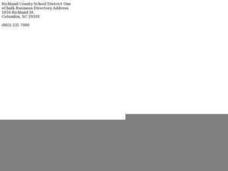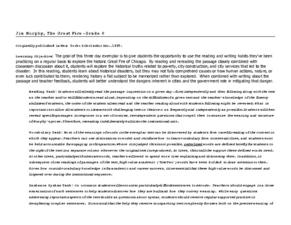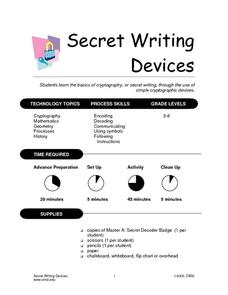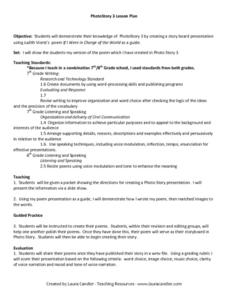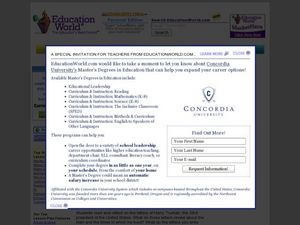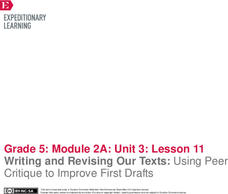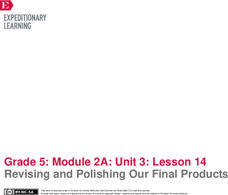Curated OER
Aesop's Fables (Grade 3)
Third graders develop a presentation based on Aesop's Fables. In this Aesop Fables and presentation instructional activity, 3rd graders examine the characteristics of fables and how to interpret them. They choose one of Aesop's Fables to...
Curated OER
How can we write a silly story?
Second graders use the writing process and create a silly story. In this silly story instructional activity, 2nd graders will review person, event and setting and complete a chart for each. Students will put a person,...
McGraw Hill
My Vocabulary Cards: Grade 4 Math
Practice your fourth grade math concepts with a series of flash cards. Covering topics such as place value, decimals, fractions, measurement, and many more, the flash cards can help learners of any level with their comprehension. The...
Curated OER
The Imagine Poetry & Mural Lesson
Readers of all ages can work together in groups to create original poetry on the theme of "Imagine," inspired by John Lennon's classic song. They also create a mural to illustrate their poetry. A beautiful lesson, inspired by a beautiful...
Curated OER
Jim Murphy, The Great Fire - Grade 6
The Great Fire by Jim Murphy provides the text for a study of the Chicago fire of 1871. The plan is designed as a close reading activity so that all learners have the same background information require for writing. Richly detailed, the...
Curated OER
Secret Writing Devices
Elementary and middle schoolers explore the world of secret writing, otherwise known as cryptography. After an interesting introduction to the activity, learners utilize a decoder badge which uses the St. Cyr cipher - which is a cipher...
Smithsonian Institution
POWs
Why did Vietnam POWs and their families receive more media attention than POWs in previous wars? To answer this question, class members view artifacts, read articles, and engage in class discussion. Individuals then assume the...
Curated OER
PhotoStory 3 Lesson Plan
In this lesson plan, PhotoStory 3, students create a story board of an original poem through the use of PhotoStory 3 presentation. Students write a poem and use it to develop their storyboard. Students publish and share their...
Curated OER
Blueprint Writing
Eighth graders write a narrative composition about funny incidents in their home lives. In this narrative writing lesson, 8th graders define what a blueprint is and draw one for their home. Students write about events that happened in...
Curated OER
The Lost Art of Letter Writing
Students discover the art of writing letters. In this writing lesson, students read letters written by President Harry Truman and then write a series of their own letters that would give insight into the times in which they live.
Curated OER
Story Writing
Young scholars work in groups to create a story that will be presented to the class. In this story writing activity, students complete a project planning sheet, work together to create a story that includes a hero and at least two...
Curated OER
Writing Applications
Ninth graders write a continuation of the book The Giver. In this novel writing instructional activity, 9th graders read the book and discussed the way Lois Lowry wrote the book. Students answer questions about the novel and write an...
Curated OER
The Writing Process
Fifth graders analyze well written and poorly written essays and define the four steps in the writing process. In this writing lesson plan, 5th graders edit poorly written essays.
Curated OER
Lesson Plan 1: Introducing NaNo and Novels
Did you know that November is Novel Writing Month? In the first of a series of lessons, class members are introduced to the NaNoWriMo (National Novel Writing Month) project.
Curated OER
Narrative Literature Response Letters: Original Lesson Plan
Readers write a formal letter to an author offering an alternative ending to a story the author has written. First, the class reads a story or novel. Upon finishing the reading, they are introduced to the format of a formal letter. They...
Curated OER
Using Color as a Pre-Writing Tool
To better understand how to compose a clear and well-organized paper, learners read short passages, write summaries, and make colored graphic organizers. This is a fully developed three-day lesson plan with suggested assessments.
Curated OER
Understanding Fantasy
Explore fantasy as a genre. After working in small groups to identify literary elements in The Lion, the Witch, and the Wardrobe by C.S. Lewis, class members share their work and then use the presentations to help them prepare to write...
Curated OER
The Hundred Penny Box with Multiple Viewpoints and Persuasive Letter
Third graders read The Hundred Penny Box and complete comprehension activities. In these perspectives and letter writing lessons, 3rd graders read and discuss the story then complete a Venn Diagram to explore the different viewpoints in...
Curated OER
Panther Exam: Writing a Play
Students demonstrate their knowledge of panthers by writing a play on the subject. In this animal life lesson, students view a slide-show on school computers of a veterinary exam of a panther. Students utilize this...
EngageNY
Writing and Revising Our Texts: Using Peer Critique to Improve First Drafts
Mail me a postcard. Individuals design a postcard to show what Meg Lowman from The Most Beautiful Roof in the
World might have written to her friends at home. They then continue to work on writing a science journal entry.
EngageNY
Revising and Polishing Our Final Products
One, two, three go! Scholars work independently to finalize the three components of their final task. They complete a science journal entry, scientific text box, and scientific drawing. While working, learners sign up for an...
EngageNY
End of Unit Assessment, Part II: Storyboard Draft, Sections 2 and 3
It's time to demonstrate knowledge. With the instructive resource, pupils complete the second part of the end of unit assessment. They develop sections two and three of their storyboards about an invention, add visual elements, and then...
EngageNY
Writing and Interpreting Inequality Statements Involving Rational Numbers
Statements often have multiple interpretations — but not these inequality statements. Scholars compare rational numbers and write inequality statements symbolically. The lesson includes problems that require comparing three numbers.
EngageNY
Reading Proficiently and Independently: The Power of Setting Goals
Scholars reflect upon their reading strengths and challenges to create personal reading goals. Participants use goal-setting verbiage in an accordion-style graphic organizer, a first step in writing a letter that details their reading...

